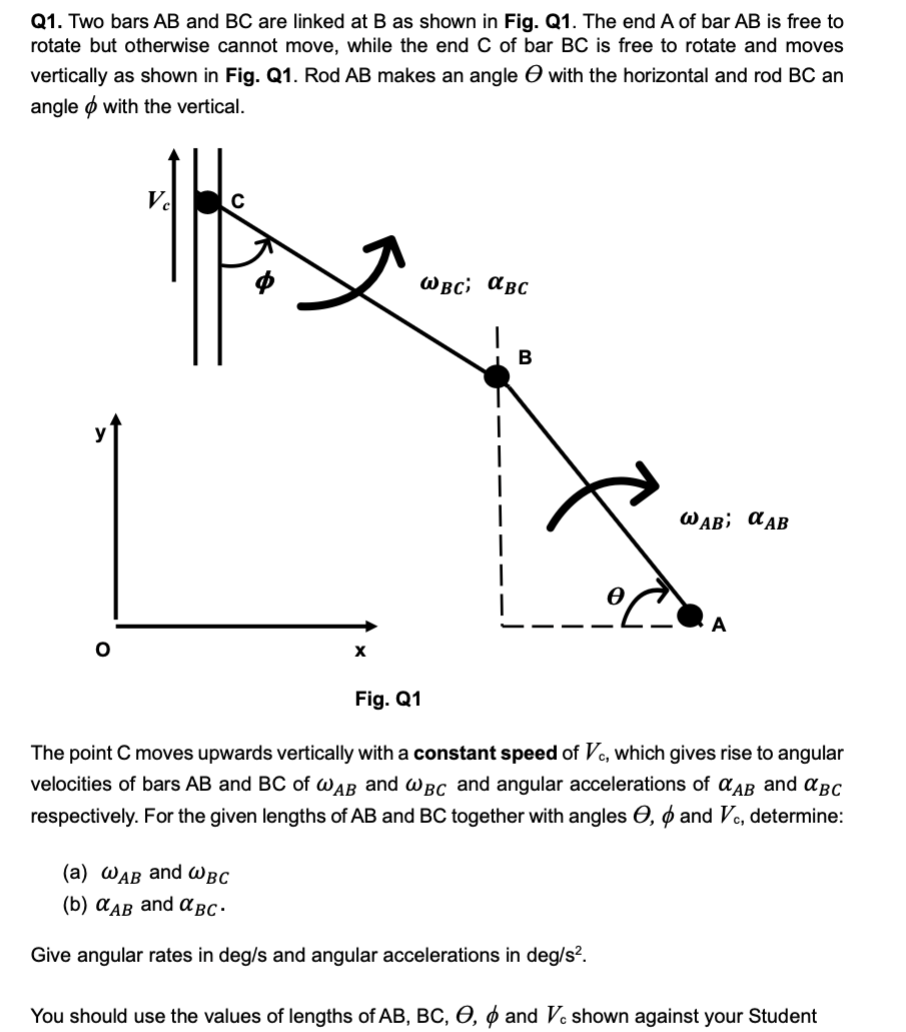Q1. Two bars AB and BC are linked at B as shown in Fig. Q1. The end A of bar AB is free to rotate but otherwise cannot move, while the end C of bar BC is free to rotate and moves vertically as shown in Fig. Q1. Rod AB makes an angle angle with the vertical. with the horizontal and rod BC an C x WBC αBC B WAB; αAB Fig. Q1 The point C moves upwards vertically with a constant speed of Vc, which gives rise to angular velocities of bars AB and BC of WAB and WBC and angular accelerations of α AB and αBC respectively. For the given lengths of AB and BC together with angles 0, & and Vc, determine: (a) WAB and WBC (b) α AB and α BC- Give angular rates in deg/s and angular accelerations in deg/s². You should use the values of lengths of AB, BC, 0, & and Vc shown against your Student
Q1. Two bars AB and BC are linked at B as shown in Fig. Q1. The end A of bar AB is free to rotate but otherwise cannot move, while the end C of bar BC is free to rotate and moves vertically as shown in Fig. Q1. Rod AB makes an angle angle with the vertical. with the horizontal and rod BC an C x WBC αBC B WAB; αAB Fig. Q1 The point C moves upwards vertically with a constant speed of Vc, which gives rise to angular velocities of bars AB and BC of WAB and WBC and angular accelerations of α AB and αBC respectively. For the given lengths of AB and BC together with angles 0, & and Vc, determine: (a) WAB and WBC (b) α AB and α BC- Give angular rates in deg/s and angular accelerations in deg/s². You should use the values of lengths of AB, BC, 0, & and Vc shown against your Student
Elements Of Electromagnetics
7th Edition
ISBN:9780190698614
Author:Sadiku, Matthew N. O.
Publisher:Sadiku, Matthew N. O.
ChapterMA: Math Assessment
Section: Chapter Questions
Problem 1.1MA
Related questions
Question
AB=1.2m.BC=0.6m.theta=25 degrees. phi=45 degrees.Vc =0.02 m/s

Transcribed Image Text:Q1. Two bars AB and BC are linked at B as shown in Fig. Q1. The end A of bar AB is free to
rotate but otherwise cannot move, while the end C of bar BC is free to rotate and moves
vertically as shown in Fig. Q1. Rod AB makes an angle with the horizontal and rod BC an
angle with the vertical.
Ve
C
x
WBC αBC
B
WAB; α AB
Fig. Q1
The point C moves upwards vertically with a constant speed of Vc, which gives rise to angular
velocities of bars AB and BC of WAB and WBC and angular accelerations of α AB and α BC
respectively. For the given lengths of AB and BC together with angles 0, & and Vc, determine:
(a) WAB and WBC
(b) αAB and α BC
Give angular rates in deg/s and angular accelerations in deg/s².
You should use the values of lengths of AB, BC, O, & and Vc shown against your Student
Expert Solution
This question has been solved!
Explore an expertly crafted, step-by-step solution for a thorough understanding of key concepts.
Step by step
Solved in 3 steps

Knowledge Booster
Learn more about
Need a deep-dive on the concept behind this application? Look no further. Learn more about this topic, mechanical-engineering and related others by exploring similar questions and additional content below.Recommended textbooks for you

Elements Of Electromagnetics
Mechanical Engineering
ISBN:
9780190698614
Author:
Sadiku, Matthew N. O.
Publisher:
Oxford University Press

Mechanics of Materials (10th Edition)
Mechanical Engineering
ISBN:
9780134319650
Author:
Russell C. Hibbeler
Publisher:
PEARSON

Thermodynamics: An Engineering Approach
Mechanical Engineering
ISBN:
9781259822674
Author:
Yunus A. Cengel Dr., Michael A. Boles
Publisher:
McGraw-Hill Education

Elements Of Electromagnetics
Mechanical Engineering
ISBN:
9780190698614
Author:
Sadiku, Matthew N. O.
Publisher:
Oxford University Press

Mechanics of Materials (10th Edition)
Mechanical Engineering
ISBN:
9780134319650
Author:
Russell C. Hibbeler
Publisher:
PEARSON

Thermodynamics: An Engineering Approach
Mechanical Engineering
ISBN:
9781259822674
Author:
Yunus A. Cengel Dr., Michael A. Boles
Publisher:
McGraw-Hill Education

Control Systems Engineering
Mechanical Engineering
ISBN:
9781118170519
Author:
Norman S. Nise
Publisher:
WILEY

Mechanics of Materials (MindTap Course List)
Mechanical Engineering
ISBN:
9781337093347
Author:
Barry J. Goodno, James M. Gere
Publisher:
Cengage Learning

Engineering Mechanics: Statics
Mechanical Engineering
ISBN:
9781118807330
Author:
James L. Meriam, L. G. Kraige, J. N. Bolton
Publisher:
WILEY